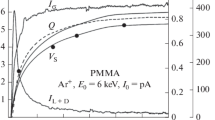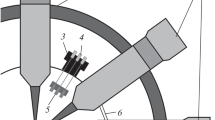Abstract
Based on a critical analysis of previous studies on the charging mechanisms of dielectric targets under the action of medium-energy (1−30 keV) electron beams, a significant number of conflicting data have been revealed in models of charging, both theoretical and experimental. The cause-and-effect relationships of the physical phenomenon of charging have been revised and refined aiming to eliminate the contradictions that have arisen in the interpretation of the processes of electronic charging of dielectrics. After extensive experimental studies of a wide class of dielectrics, general regularities of the kinetics of charging dielectric targets have been established depending on the number of initial and radiation-induced traps, the density j0 of current of irradiating electrons and their energy E0. The secondary emission properties of a charged dielectric are shown to be fundamentally different from those of an uncharged one, and the electron emission coefficient σ, depending on E0, is not the only determining factor of positive or negative charging. When considering the processes of charging, for the first time, primary thermalized electrons are taken into account, which significantly change the general charging scenario, and the key role of the density of the formed radiation defects in charging kinetics is shown. In the proposed model, the decisive stabilizing effect of the onset of equilibrium state charging is the internal electric field Fdip generated during irradiation between the positive and negatively charged layers in the near-surface region of the dielectric. The main driving factor of the self-regulating self-consistent process of charging dielectrics under electron irradiation is not only the electron emission coefficient, as has been generally believed earlier, but the formation of the electric field of the dipole layer of charges. This critical control field Fcr is of the order of 0.5 MV/cm. This field is approximately the same for all dielectrics at any values of E0.












Similar content being viewed by others
REFERENCES
L. B. Schein, Science (Washington, DC, U. S.) 316, 1573 (2007).
H. Miyake, K. Nitta, S. Michizono, and Y. Saito, J. Vac. Soc. Jpn. 50, 378 (2007).
M. I. Panasyuk and L. S. Novikov, The Model of Space (KDU, Moscow, 2007) [in Russian].
I. M. Bronshtein and B. S. Fraiman, Secondary Electron Emission (Nauka, Moscow, 1969) [in Russian].
L. Reimer, Scanning Electron Microscopy: Physics of Image Formation and Microanalysis (Springer, Berlin, 1998).
J. Cazaux, Nucl. Instrum. Methods Phys. Res., Sect. B 244, 307 (2006).
J. Cazaux, J. Electron. Spectrosc. Rel. Phenom. 176, 58 (2010).
A. Melchinger and S. Hofmann, J. Appl. Phys. 78, 6224 (1995).
E. N. Evstaf’eva, E. I. Rau, V. N. Mileev, L. S. Novikov, S. A. Ditsman, and R. A. Sennov, Persp. Mater. 4 (11) (2010).
I. A. Glavatskikh, V. S. Kortov, and H.-J. Fitting, J. Appl. Phys. 89, 44 (2001).
M. Touzin, D. Goeuriot, C. Guerret-Piecourt, D. Juve, D. Treheux, and H.-J. Fitting, J. Appl. Phys. 99, 114110 (2006).
N. Cornet, D. Goeuriot, C. Guerret-Piecourt, D. Juve, D. Treheux, M. Touzin, and H.-J. Fitting, J. Appl. Phys. 103, 064110 (2008).
V. V. Aristov, L. S. Kokhanchik, K. P. Meyer, and H. Blumtriff, Phys. Status Solidi A 78, 229 (1983).
L. Frank, M. Zadrazil, and I. Mullerova, Microchim. Acta 13, 289 (1996).
M. Belhaj, O. Jbara, M. N. Filippov, E. I. Rau, and M. V. Andrianov, Appl. Surf. Sci. 177, 58 (2001).
S. Fakhfakh, O. Jbara, M. Belhaj, Z. Fakhfakh, A. Kallel, and E. I. Rau, Eur. Phys. J. Appl. Phys. 21, 137 (2003).
H. Gong and C. Ong, J. Appl. Phys. 75, 449 (1994).
J. Liebault, K. Zarbout, D. Moya-Siesse, J. Bernardini, and G. Moya, Appl. Surf. Sci. 9852, 1 (2003).
A. Boughariou, G. Blaise, D. Braga, and A. Kallel, J. Appl. Phys. 95, 4117 (2004).
K. Zarbout, A. Ahmed, G. Moya, J. Bernardini, D. Goeuriot, and A. Kallel, J. Appl. Phys. 103, 054107 (2008).
K. Said, G. Damamme, A. Ahmed, G. Moya, and A. Kallel, Appl. Surf. Sci. 297, 45 (2014).
M. Boubaya and G. Blaise, Eur. Phys. J. Appl. Phys. 37, 79 (2007).
T. Thome, D. Braga, and G. Blaise, J. Appl. Phys. 95, 2619 (2004).
S. Le Roy, F. Baudoin, V. Griseri, and G. Teyssedre, J. Appl. Phys. 112, 023704 (2012).
B. Raftary, N. V. Budko, and C. Voik, J. Appl. Phys. 118, 204101 (2015).
R. Pacaud, T. Paulmier, and P. Sarrailh, J. Appl. Phys. 122, 245106 (2017).
N. Chorbel, A. Kallel, and G. Damamme, Micron 112, 35 (2018).
J. Liu, H.-B. Zhang, Y.-H. Ding, Z. Yan, J. Tong, Y. Yuan, and Q. Zhao, Micron 16, 100 (2019).
E. I. Rau, A. A. Tatarintsev, E. Yu. Zykova, I. P. Ivanenko, S. Yu. Kupreenko, K. F. Minnebaev, and A. A. Khaidarov, Phys. Solid State 59, 1526 (2017).
E. I. Rau, A. A. Tatarintsev, and E. Y. Zykova, Nucl. Instrum. Methods Phys. Res., Sect. B 460, 141 (2019).
E. N. Evstaf’eva, E. I. Rau, and A. A. Tatarintsev, Mosc. Univ. Phys. Bull. 68, 128 (2013).
B. Askri, K. Raouadi, R. Renoud, and B. Yangui, J. Electrostat. 67, 695 (2009).
M. Kotera, K. Yamaguchi, and H. Suga, Jpn. J. Appl. Phys. 38, 7176 (1999).
A. Palov, H. Fujii, Yu. Mankelevich, T. Rakhimova, and M. Baklanov, Polym. Degrad. Stab. 97, 802 (2012).
J. P. Vigourous, J. P. Duraud, A. Le Moel, and C. Le Gressus, J. Appl. Phys. 57, 5139 (1985).
G. Blaise and C. Le Gressus, AIP Adv. 8, 095228 (2018).
R. Hofmann, J. R. Dennison, C. D. Thomson, and J. Albertsen, IEEE Trans. Plasma Sci. 36, 2238 (2008).
R. Hofmann and J. R. Dennison, IEEE Trans. Plasma Sci. 40, 298 (2012).
T. Paulmier, R. Hanna, M. Belhaj, et al., IEEE Trans. Plasma Sci. 41, 3422 (2013).
K. Guerch, T. Paulmier, J. R. Dennison, J. Dekany, P. Lenormand, and F. Guillemet-Fritsch, J. Spacecr. Rockets 53, 1100 (2016).
A. I. Titov and S. O. Kucheyev, J. Appl. Phys. 92, 5740 (2002).
R. Renoud, F. Mady, C. Attard, J. Beigarre, and J.‑P. Ganachaud, Phys. Status Solidi A 201, 2119 (2004).
S. G. Boyev, V. A. Paderin, and A. P. Tyutnev, J. Electrostat. 26, 133 (1991).
D. J. DiMaria, E. Cartier, and D. Arnold, J. Appl. Phys. 73, 3367 (1993).
V. S. Vavilov, A. S. Kiv, and O. R. Niyazova, Defect Formation and Migration Mechanisms in Semiconductors (Nauka, Moscow, 1981) [in Russian].
Funding
The work was supported by the Russian Foundation for Basic Research (project no. 18-02-00813).
Author information
Authors and Affiliations
Corresponding author
Ethics declarations
The authors declare that they have no conflicts of interest.
Additional information
Translated by G. Dedkov
Rights and permissions
About this article
Cite this article
Rau, E.I., Tatarintsev, A.A. A New Scenario for the Kinetics of Charging Dielectrics under Irradiation with Medium-Energy Electrons. Phys. Solid State 63, 628–643 (2021). https://doi.org/10.1134/S1063783421040181
Received:
Revised:
Accepted:
Published:
Issue Date:
DOI: https://doi.org/10.1134/S1063783421040181




